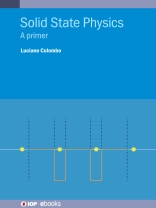This book is a self-contained undergraduate textbook in solid state physics. Most excellent existing textbooks in this area are aimed at advanced students and/or have an encyclopaedic content, therefore, they are often overwhelmingly difficult and/or too wide for undergraduates. On the contrary, this book is designed to accompany a one-semester, second or third-year course aimed at a tutorial introduction to solid state physics.
The book is highly accessible and focuses on a selected set of topics (basically, the physics of phonons and electrons in crystals), whilst also providing substantial, in-depth coverage of the subject. Emphasis is given to the underlying physical basis or principle for each topic, although applications are covered when it is possible to link them to fundamental physical concepts in a simple way.
The author has taught undergraduate condensed matter physics for 17 years, and the book is based on this experience. Various pedagogical features are used in each chapter, including conceptual layout sections (defining the syllabus of each chapter), extensive use of figures (used to illustrate concepts, or to sketch experimental setups, or to present paradigmatic results) and highlights on the most important equations, definitions, and concepts.
Key Features
- Fills a gap for a self-contained undergraduate textbook in solid state physics
- Tailored for a one-semester course
- Focuses on a selected set of topics (basically, the physics of phonons and electrons in crystals), whilst also providing substantial, in-depth coverage of the subject
- Emphasises phenomenology rather than mathematics/formalism
- Uses various pedagogical features, including end-of-chapter exercises with solutions
O autorze
Luciano Colombo is a full professor of theoretical condensed matter physics at the University of Cagliari and fellow of the Istituto Lombardo Accademia di Scienze e Lettere. He has been doing theoretical and computational research on materials physics for more than 30 years, has published more than 270 scientific papers and lead several research projects. He has been the mentor of more than 100 students at the bachelor, master, Ph D or post-doc level.












